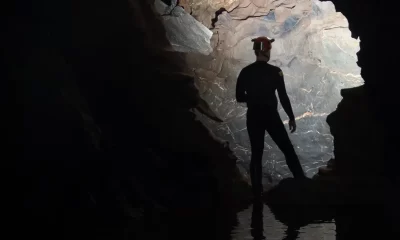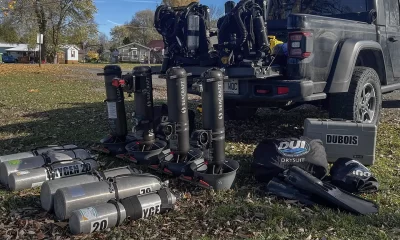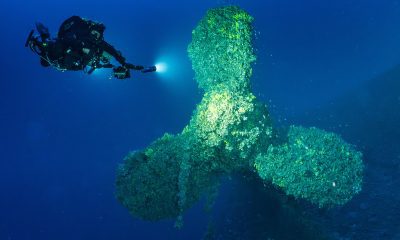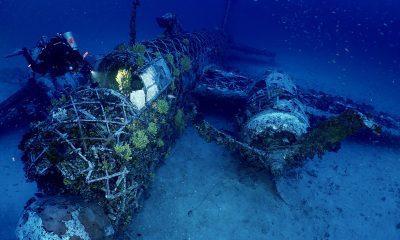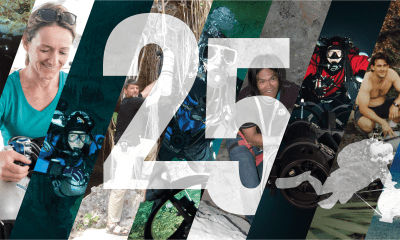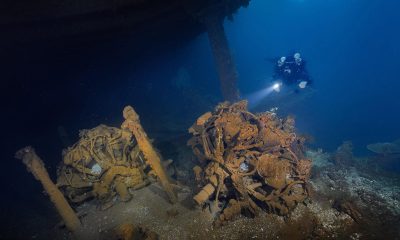Exploration
RELITTO VIMINALE: UNO SGURADO SUL TITANIC ITALIANO
Il giovane esploratore e poeta italiano Andrea Murdock Alpini rivela la sensibilità della sua non così discreta storia d’amore con il relitto della Motonave Viminale, il Titanic italiano, che giace a più di 100 metri sotto il mare vicino a Palmi, in Italia. Come cantavano i Bee Gees, “Quant’è profondo il tuo amore?” Testo in inglese e italiano.
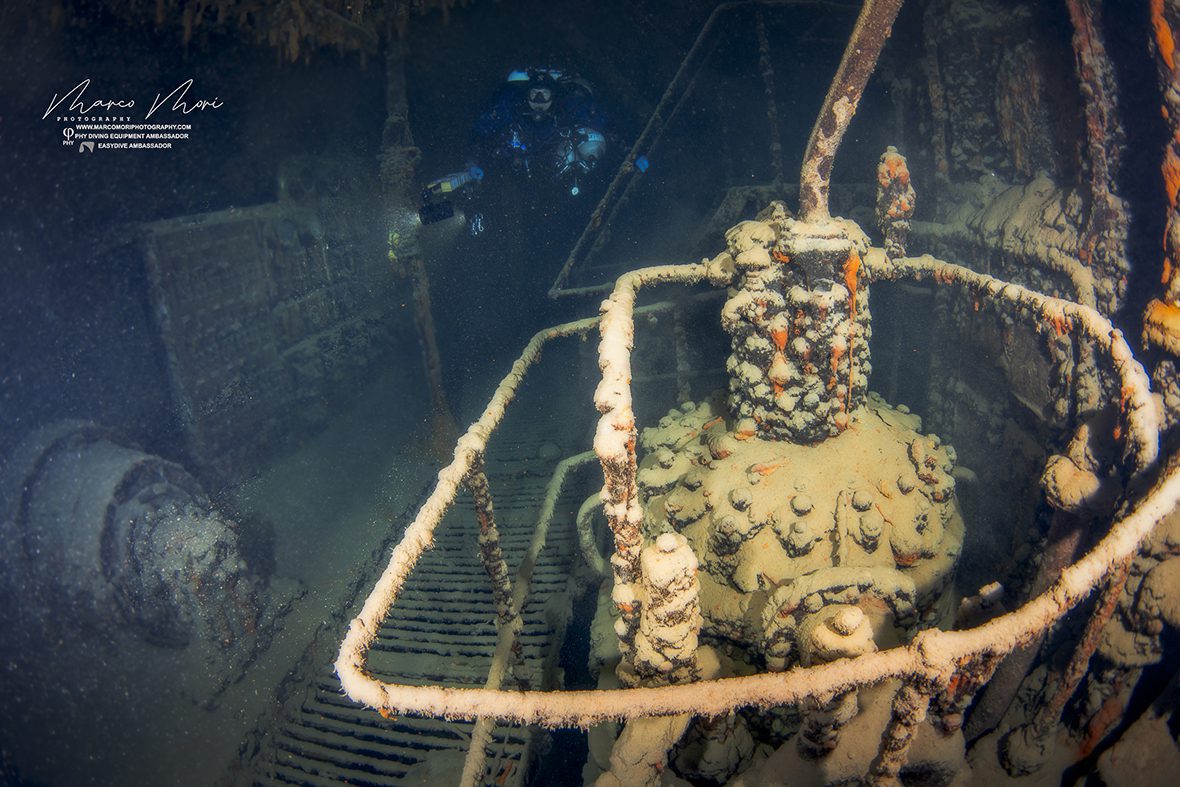
Testo: Andrea Murdock Alpini (relittaro profondista, fondatore di Phy Diving Equipment)
Traduzione: Lara Lambiase (DAN Europe, Diving Medical Officer) AKA Lady Murdock
Immagini subacqee: Marco Mori
You can read this story in English here
Correre incontro ai propri sogni è ciò cui tutti vorrebbero tendere. Sfiorarli è un successo che alcune persone hanno il privilegio di raggiungere. Raccoglierli a piene mani è un dono per pochi.
Il vento della vita soffia spesso in modo incostante e in molteplici direzioni. Capire quale sia la giusta via da seguire richiede uno sforzo analitico importante.
Stati d’animo: gli addii
Lasciarsi alle spalle un relitto è una pratica che richiede coraggio. Voltarsi e decidere che quella sarà l’ultima volta che lo si vede, che si sta con e dentro di lui, è una scelta forte. È un po’ come starsene sulla soglia di casa a salutare chi riparte dopo essere venuto da lontano. Dare un addio implica la fine e impone l’inizio della distanza che sposta quella relazione nel ricordo.
La prima volta che sono sceso sulla Motonave Viminale ho capito che non sarebbe mai stato un addio. L’abbraccio che mi ha avvolto tra le sue delicate lamiere, la prima volta, il suo tatto e quella voce fatta di lunghi corteggiamenti a distanza mi hanno così affascinato che non ho potuto smettere di pensare a lei, a quella fascinosa ed elegante nave.
Un transatlantico per forma, dimensione, storia e portata ha un carattere unico.
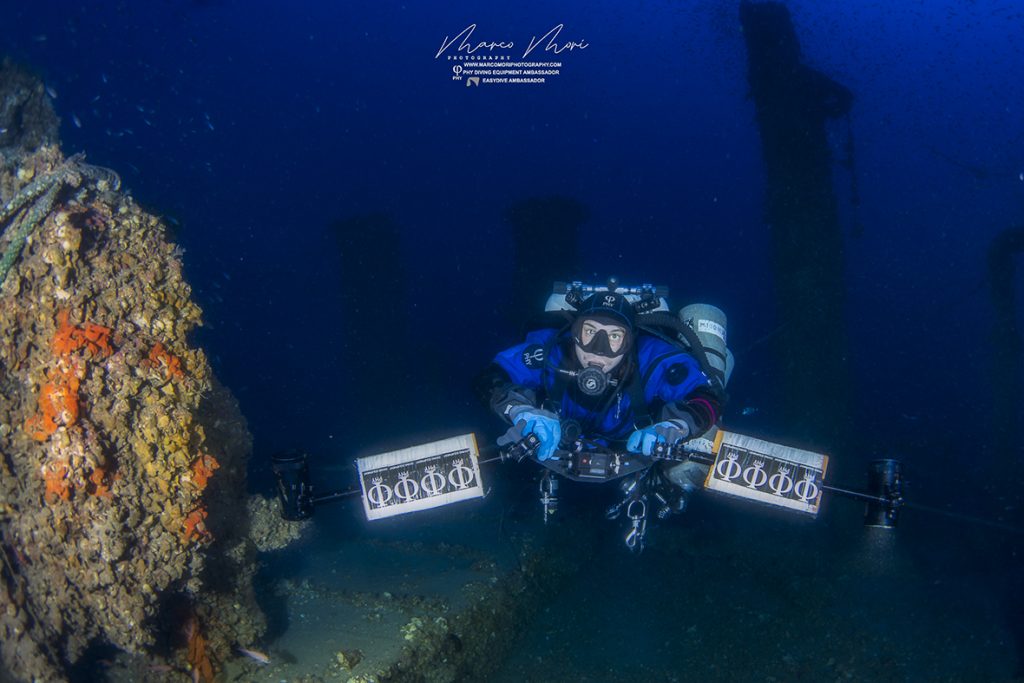
Il primo incontro non lo scordi mai. In pochi istanti ti ha già trasmesso il carattere di cui è capace. Il tuo sguardo di imberbe osservatore degli abissi non vuole più fermarsi alla superficie. “In ogni cosa c’è una frattura”, una crepa che permette lo slancio verso l’interno, il luogo in cui delicati mondi si aprono o si chiudono. Dopo un impatto simile non puoi più dire “addio”.
Ricordo le prime e consecutive immersioni, un anno fa, dopo aver a lungo aspettato l’incontro. Penelope ingannava il tempo nell’attesa di Ulisse, il marinaio annega il tempo tra un porto e l’altro mentre il soldato imbarcato fuma tizzoni di sigaretta avvinghiato nella sua coffa, di guardia.
Imbattersi un giorno nel relitto della Viminale è stata una della più forti e sconvolgenti esperienze di vita.
In quei primi nostri sguardi c’era il passato ma soprattutto la nostalgia del presente.
Il futuro del Classico
Guardare la Viminale richiede molta attenzione, sia che tu stia pensando di guardare la nave sia che tu veda il relitto. Di primo acchito tutti vedono il relitto poi se lo osservi bene e con occhi nuovi appare lei, la fascinosa nave del Lloyd Triestino. Se la vedi non puoi più farne a meno.

Vuoi tornare, ancora e ancora e ancora. Il tuo sguardo non sarà mai soddisfatto dalla sua bellezza e dal tuo spirito di conoscenza che ti porta a esplorare i nuovi confini personali. Tutto ciò è come vedere contemporaneamente il volto di una donna che per un istante appare giovane ragazza e immediatamente è donna.
Coesistono due aspetti.
Inseparabili, ma anche così lontani tra di loro se non sai vederli. Il primo corrisponde al relitto, a ciò che tutti osservano quando poggiano gli sguardi su di lei, il secondo invece è il futuro di uno sguardo classico. La donna è invisibile agli occhi perché celata da diverse sovrastrutture che le hanno dato forma, nel tempo. La donna che appare mentre guardi la ragazza è La Nave: “una forza del passato che trova la sua forza nella tradizione” dell’amore.
Amore per chi? Del mare a cui appartiene dal momento in cui galleggia a quello in cui affonda tra le sue onde.
L’ho già scritto altre volte, ma l’urlo di gioia che feci di fronte alla Nave a -107m è ciò che mi ha fatto innamorare di questo relitto. Fino ad allora avevo visto soltanto la ragazza, poi d’improvviso apparve la Donna.
Le mani dell’alpinista Walter Bonatti erano spesse ma nonostante ciò tagliate dal freddo. Le mani di chi va per relitti tastano, accarezzano, tirano con foga o delicatezza. Le mani per noi relittari sono più che occhi, sentono, guardano, percepiscono. A volte affondano come i polpastrelli di marmo di Amore dentro Psyche. Il tocco è energico ma conoscitivo. Le mani si avvinghiano, le dita si stringono come in una danza di pianista.
Le parole dipinte

Quando guardo la superficie dal fondo, qualche volta intravedo il lontano bagliore della superficie. Talvolta un raggio di luce colma la distanza che separa il relitto della vita. Allora mi brillano gli occhi perché improvvisamente sono reso partecipe di un evento straordinario, quello della bellezza al naturale. Non serve più illuminare nulla, è già tutto lì.
Questa volta il pesante pedagno da 45kg. Da gettare sul relitto l’ho caricato con me nell’abitacolo, sentivo che non meritava il freddo cassone posteriore. Guardandolo ho avuto l’idea che questa volta, sul fondo, non sarebbe sceso nudo. Servivano delle parole dipinte per accompagnarlo.
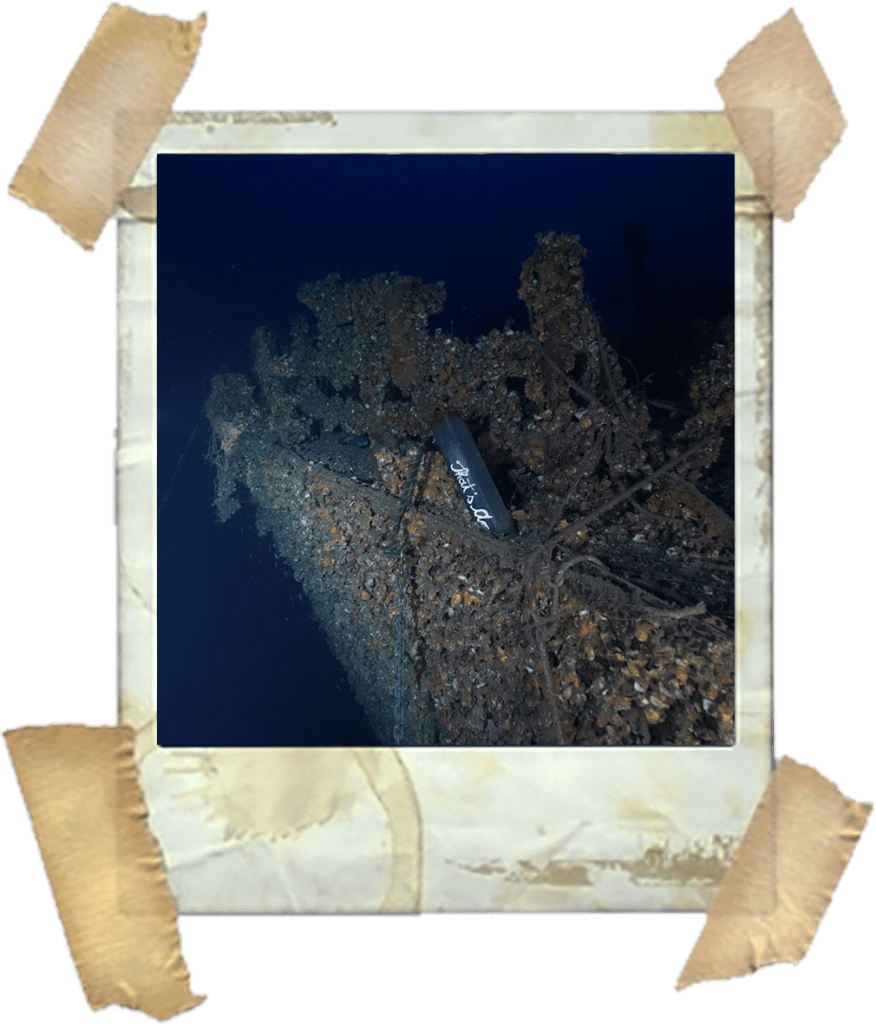
Tracciare morbide linee a smalto bianco da un lato e lettere latine dall’altro. Non poteva che essere così, l’inizio di una storia d’amore, aprire una fessura in ogni cosa, perché tutto cambi.
Il primo impatto ha cambiato il corso degli eventi in modo del tutto inaspettato.
Ho preso un pennello per scrivere sul tuo fianco THAT’S AMORE perché laggiù è così che scendo.
Ogni uomo e ogni nave attraversano tempeste, barra del timone e nocchiero fanno la rotta, indissolubilmente uniti anche se visivamente lontani tra loro.
“Resta con me e la tempesta cesserà”.
Come te, nessuno. Mai
Increduli.
Le attrazioni spesso sono magnetiche e ti portano a fare delicate follie.
Un anno fa insieme a un paio di compagni d’immersione siamo entrati in sala macchine della Motonave Viminale. Un anno dopo, insieme a Marco Mori, sono tornato in quel luogo che tanto mi aveva dato quindici mesi prima. Due gli scenari pianificati, 25 minuti di fondo se le condizioni di visibilità e corrente dovessero essere “impegnative” e 35 minuti qualora tutto dovesse andare per il meglio.
Tornando in superficie ci siamo meravigliati della pacatezza con cui abbiamo passato quei 30 minuti dentro la sala macchine del transatlantico italiano, tra manometri, quadri elettrici, alza valvole e lampadine che hanno smesso di brillare. Ricordo il silenzio cadenzato dai brividi, dei sorrisi fatti con gli occhi, le lente pinneggiate e le legature di spool: questi sono stati gli elementi che ci hanno accompagno laggiù. “Bisogna muoversi con delicata attenzione, per non disturbare”.
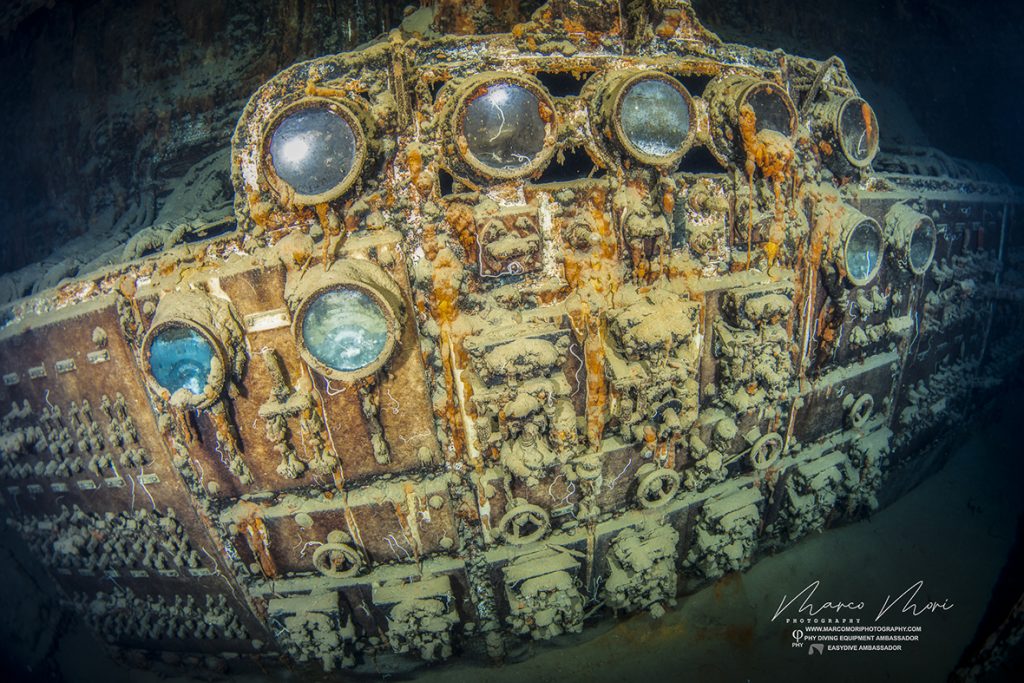
Quando rimetto la testa fuori dall’osteriggio non credo a quel vedo.
Complice il buio da cui veniamo, oltre al fatto che i nostri occhi si stanno abituando alla tenebra, ora appare il Blu di Palmi in una tonalità Oltremare. La plancia e ciò che resta dei bracci cala scialuppe appaiono come sculture. Andiamo oltre, ci dirigiamo in direzione opposta al grappolo delle nostre stage cha abbiamo lasciato alla base del pedagno. Ora siamo avvolti dal mare a -90m, abbiamo lasciato i -105m dello scrigno motoristico poco fa. Spazzolo il teak della plancia, indico a Marco Mori le vie di fuga tra le assi. Per me che amo il ferro, toccare il legno di queste Navi dal fascino di un’epoca che non esiste più è sempre un’emozione unica. Lo avevo fatto anche lungo le promenade dell’HMHS BRITANNIC, due anni prima.
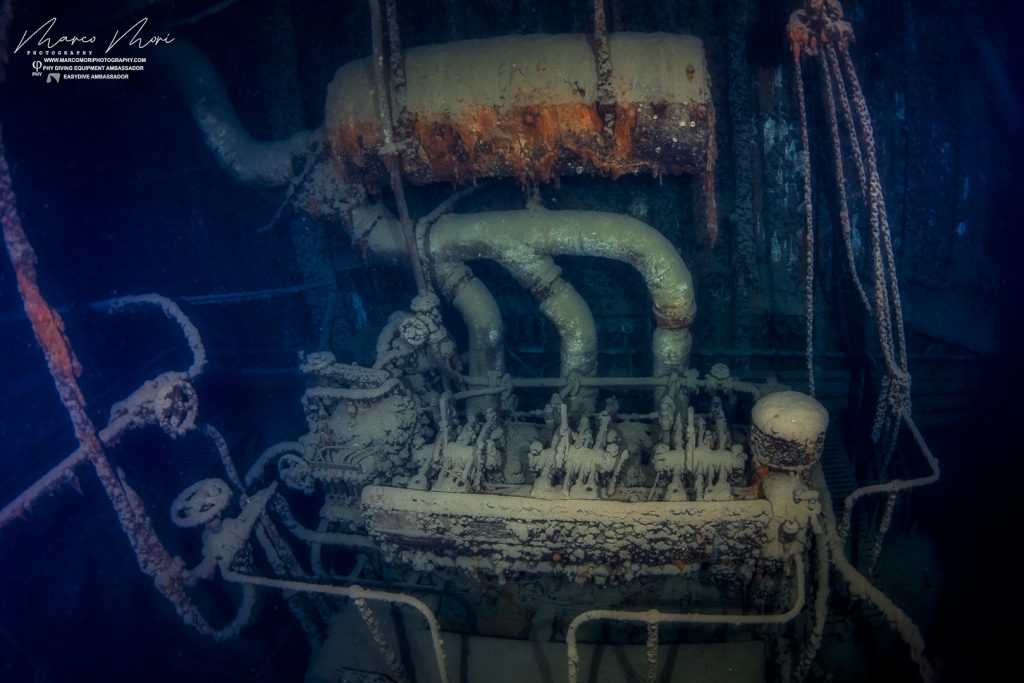
Un ultimo sguardo commosso alla murata del cassero che stacca verso la coperta di prua ed ora di rientrare. Il RunTime suona la carica, i numeri digitali dicono che dal momento in cui lasceremo il relitto dovranno passare altri 190min prima che gli occhi si trovino al di sopra del pelo dell’acqua.
Stacco il mio grappolo di bombole, passo l’ossigeno a Marco che saluta a gran voce la Motonave Viminale. Riemergo convinto che sia stata la nostra più bella immersione per ambienti visitati, per tecnica subacquea e qualità dell’interazione oltre che per la pacatezza con cui è stata vissuta in tutte le sue fasi.
Si conclude così un paragrafo di questa Nave. Non ci sentiamo di aver concluso il nostro lavoro. Torneremo, ancora una volta e poi ancora e poi ancora … Spengo i fari. Siamo arrivati al punto di risalita: resta l’ambiente al naturale, resta l’essenziale, quello che quando arrivi è invisibile agli occhi. “È solo l’ombra della luce”.
Gli incontri che pensi impossibili con una donna, un amico o un relitto, a volte ti stravolgono e ti portano a cambiare i tuoi orizzonti, per sempre.
“E ti vengo a cercare con la scusa di doverti parlare”, forse è per questo che passo le notti insonni pensando al desiderio di rivederti l’indomani. Questa Nave è diventata parte della mia vita, non mi importa chi ti ha avuto, sono tornato dipingendoti That’s Amore. Dopotutto vorrei sognarti come non ti ho sognato mai, perché “Tu, tu non mi basti mai”.
You can read this story in English here

Andrea Murdock Alpini è istruttore tecnico TDI and CMAS, insegna trimix ipossico, penetrazioni avanzate in relitti e full cave. È appassionato di studi sulla decompressione, ricerche storiche e accompagna inoltre le sue immersioni ed esplorazioni con filmati e report. HA conseguito la Laurea Specialistica in Architettura e un MBA in Economia dell’Arte e dei beni Culturali. Andrea Murdock Alpini è inoltre fondatore del brand Phy Diving Equipment. La sua vita ruota attorno all’insegnamento della subacquea a circuito aperto, organizzare spedizioni subacquee, sviluppare attrezzatura, scrivere saggi e report circa il suo particolare modo di intendere la subacquea profonda su relitti e in grotta. Recentemente è stato pubblicato il suo libro intitolato: Deep Blue: storie di relitti e luoghi insoliti.



















